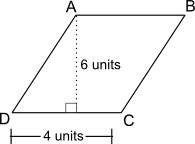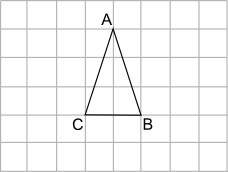
Mathematics, 22.10.2019 05:10 cocobelle
1.what is the area, in square units, of the parallelogram shown below?
12 square units
18 square units
24 square units
36 square units
2.which statement best describes the area of triangle abc shown below?
it is one-half the area of a rectangle with sides 2 units × 3 units.
it is twice the area of a rectangle with sides 2 units × 3 units.
it is one-half the area of a square of side length 3 units.
it is twice the area of a square of side length 3 units




Answers: 1


Other questions on the subject: Mathematics

Mathematics, 21.06.2019 13:00, bellagracebulle8018
Me what is the value of x? showing work would be appreciated - ! : )
Answers: 1


Mathematics, 21.06.2019 19:20, alexcarrasco5903
1- is the product of two rational numbers irrational or rational? first, make a hypothesis by multiplying two rational numbers. then, use variables such as x=a/b and y=c/d and the closure property of integers to prove your hypothesis. 2- what do you think the product of a nonzero rational number and an irrational number is? is it rational or irrational? make use of variables, the closure property of integers, and possibly a proof by contradiction to prove your hypothesis. 3- why do we have to specify that the rational number must be nonzero when we determine what the product of a nonzero rational number and an irrational number is? if the rational number were 0, would it give us the same result we found in part b?
Answers: 3

Mathematics, 21.06.2019 23:30, 20lap01
(c) compare the results of parts (a) and (b). in general, how do you think the mode, median, and mean are affected when each data value in a set is multiplied by the same constant? multiplying each data value by the same constant c results in the mode, median, and mean increasing by a factor of c. multiplying each data value by the same constant c results in the mode, median, and mean remaining the same. multiplying each data value by the same constant c results in the mode, median, and mean decreasing by a factor of c. there is no distinct pattern when each data value is multiplied by the same constant. (d) suppose you have information about average heights of a random sample of airline passengers. the mode is 65 inches, the median is 72 inches, and the mean is 65 inches. to convert the data into centimeters, multiply each data value by 2.54. what are the values of the mode, median, and mean in centimeters? (enter your answers to two decimal places.) mode cm median cm mean cm in this problem, we explore the effect on the mean, median, and mode of multiplying each data value by the same number. consider the following data set 7, 7, 8, 11, 15. (a) compute the mode, median, and mean. (enter your answers to one (1) decimal places.) mean value = median = mode = (b) multiply 3 to each of the data values. compute the mode, median, and mean. (enter your answers to one (1) decimal places.) mean value = median = mode = --
Answers: 1
You know the right answer?
1.what is the area, in square units, of the parallelogram shown below?
12 square units<...
12 square units<...
Questions in other subjects:

Mathematics, 13.01.2021 01:20


Chemistry, 13.01.2021 01:20


Mathematics, 13.01.2021 01:20


Chemistry, 13.01.2021 01:20

History, 13.01.2021 01:20


Biology, 13.01.2021 01:20









